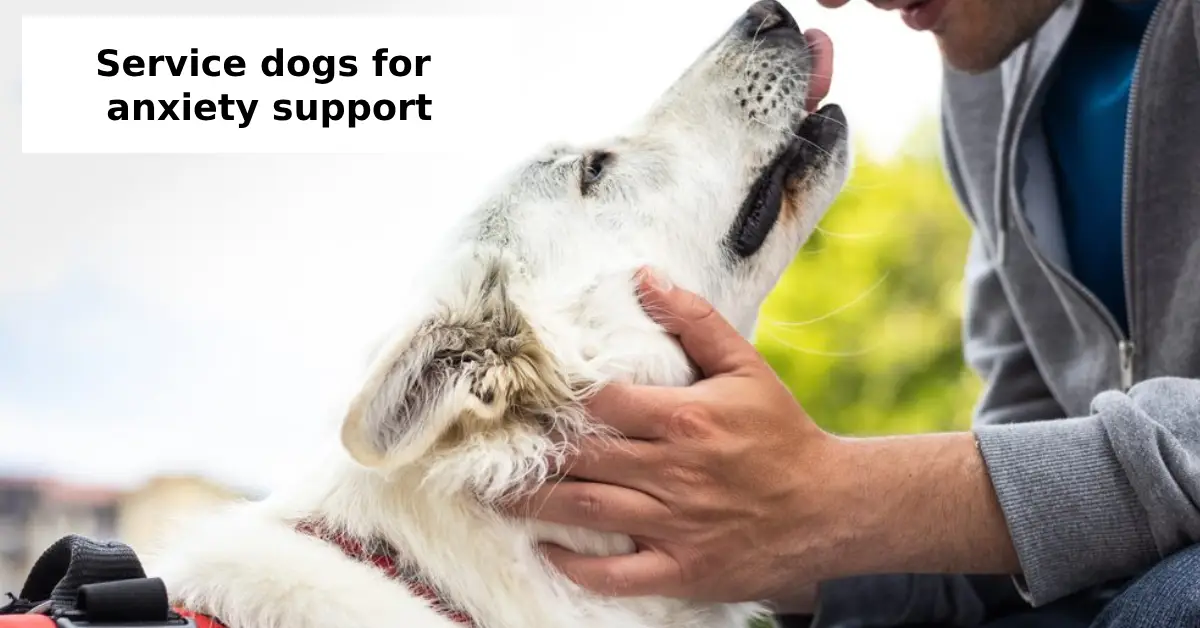Living with anxiety can be overwhelming, but having the right support system can make a world of difference. For many people, service dogs for anxiety support offer more than just comfort — they provide critical assistance in managing symptoms, promoting independence, and improving quality of life. Whether you’re exploring options for yourself or a loved one, choosing the right service dog is a deeply personal and impactful decision.
In this guide, we’ll walk you through everything you need to know — from qualifications and breed selection to training, certification, and understanding the difference between emotional support dogs and service dogs. Designed with transparency and accuracy, this blog follows expert-backed advice aligned with EEAT and Yoast SEO guidelines.
Why Consider a Service Dog for Anxiety Support?
Anxiety disorders are among the most common mental health conditions, affecting millions of people in the United States alone. Adults with diagnosed anxiety or panic disorders, college students dealing with stress and anxiety, and veterans with PTSD often look for long-term, non-medication-based solutions. That’s where psychiatric service dogs for anxiety come in.
Unlike emotional support animals, which provide comfort through companionship, service dogs are specially trained to perform tasks that directly assist with a person’s disability. For example, they can interrupt anxiety attacks, fetch medication, provide deep pressure therapy, or guide you to safety during panic episodes.
Emotional Support Dog vs Service Dog: What’s the Difference?
Understanding the emotional support dog vs service dog distinction is crucial. Emotional support dogs (ESAs) provide comfort through companionship but are not protected under the Americans with Disabilities Act (ADA). This means they don’t have public access rights and typically require only a letter from a licensed mental health professional.
On the other hand, certified service dogs for anxiety in the USA must be trained to perform specific tasks related to a person’s disability. They’re legally allowed in public spaces like restaurants, airplanes, and stores — where ESAs may be restricted.
If you’re researching ESA vs service dog options, be clear about what legal access, responsibilities, and support needs you have before choosing one.
How to Qualify for a Psychiatric Service Dog for Anxiety
Wondering how to qualify for a psychiatric service dog? You must:
- Have a medically diagnosed anxiety disorder (e.g., GAD, PTSD, panic disorder)
- Get a recommendation from a licensed mental health professional
- Be capable of caring for and handling a service dog
- Have symptoms that significantly impair daily functioning
Therapists and mental health professionals can guide you through the documentation and also help you determine if this is the right choice over medications or therapy alone.
Choosing the Best Service Dog Breeds for Mental Health
While any breed can potentially become a service dog, certain service dog breeds for mental health are known for their temperament, intelligence, and trainability. The best service dogs for anxiety and depression are often those that are calm, alert, and eager to please.
Common Breeds Used:
- Labrador Retriever – Friendly, easy to train, and great for emotional support
- Golden Retriever – Loyal, intuitive, and patient
- Poodle – Intelligent and hypoallergenic
- Boxer – Energetic but highly affectionate
- Cavalier King Charles Spaniel – Ideal for small service dogs for anxiety
People often ask dog trainers specializing in service or therapy dogs for breed-specific recommendations that suit their environment and anxiety symptoms.
Cost of a Service Dog for Anxiety in USA
The cost of a service dog for anxiety in the USA can range from $15,000 to $40,000, depending on the organization and training level. This may include:
- Basic and advanced task training
- Socialization and public access training
- Health checks, vaccinations, and microchipping
Some non-profits help parents of teens with anxiety or social phobia by offering grant-based or subsidized programs. Always verify that the provider is reputable and transparent.
Training a Service Dog for Anxiety Support
Professional training ensures your service dog performs tasks reliably and behaves appropriately in public. Training a service dog for anxiety support typically includes:
- Basic obedience
- Public access training
- Task-specific behaviors (interrupting panic attacks, providing pressure therapy, etc.)
You may opt for professional trainers or do it yourself if you’re confident. However, working with dog trainers specializing in service or therapy dogs often results in more consistent outcomes.
For advanced behavioral work, such as aggression correction, you may want to explore dog aggression training methods (internal link).
Service Dog Requirements for Anxiety
Meeting the service dog requirements for anxiety involves more than having a diagnosis. You must also ensure:
- The dog is well-behaved in public
- The dog can perform at least one task directly related to your anxiety disorder
- You maintain control over the dog at all times
This is particularly important for disability rights advocates focused on ensuring the legitimacy and ethical use of service dogs in public settings.
Certified Service Dog for Anxiety in USA: What to Know
There is no official registry required by the U.S. government, but many organizations offer certified service dogs for anxiety in the USA through structured programs. Certification may include:
- Documentation of training hours
- Verification of public access test
- Handler-dog bonding certification
It’s also wise to carry an ID or medical letter for smoother interactions in public, though not legally required.
Alternatives and Considerations
Not everyone is ready for the responsibility of a full-time service dog. People exploring alternatives to medication for anxiety often weigh therapy, lifestyle changes, or ESAs as interim solutions.
For others, particularly individuals researching ESA vs service dog options, it’s important to consider your:
- Living situation
- Financial ability
- Travel needs
- Commitment to long-term dog care
Final Thoughts:
Choosing the right service dogs for anxiety support is about more than finding a furry companion — it’s about building a reliable support system that empowers you to live more freely and confidently. Whether you’re a college student dealing with stress, a parent of a teen with social anxiety, or a veteran with PTSD, there’s a dog and training method tailored to your journey.
Work with therapists and mental health professionals, certified trainers, and reputable providers to ensure you’re on the right path. The right dog can truly be life-changing.
FAQs
Q. Can any dog be a service dog for anxiety?
Technically yes, but they must be trained to perform specific tasks and behave well in public.
Q. Do service dogs for anxiety support need certification?
No official U.S. certification is required, but trained and tested service dogs often come with verification documents.
Q. What is the difference between psychiatric service dogs and emotional support dogs?
Psychiatric service dogs are task-trained and have public access rights under ADA; ESAs are not.





